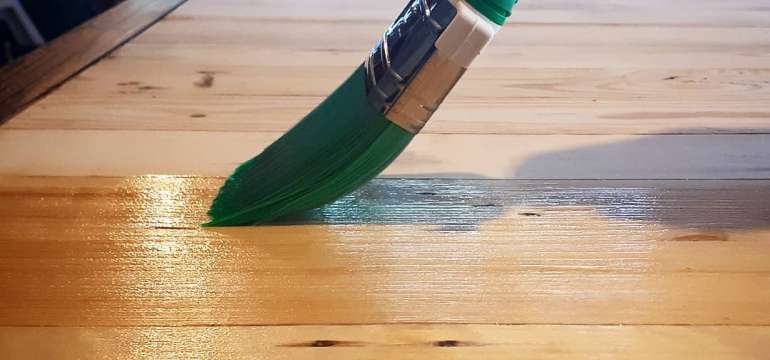So you are working on a wood project of some kind, and perhaps you have decided that you want a natural oil finish for the piece. There are a number of different oils available for treating and finishing wood.
However, two of the most popular types of oil are tung oil and Danish oil. In this guide, we will explore Danish oil vs. tung oil. If you are not sure what each oil is and what components make it special, it is important to do thorough research so that you can be sure you are using the right kind of oil for your project.
What Is Danish Oil?
 Danish oil is a kind of oil used in finishing various types of wood. A popular brand of Danish oil is Watco Danish oil. As you further explore this kind of finish, you will discover that Danish oil is actually a mix of varnish with oil.
Danish oil is a kind of oil used in finishing various types of wood. A popular brand of Danish oil is Watco Danish oil. As you further explore this kind of finish, you will discover that Danish oil is actually a mix of varnish with oil.
Danish oil was first invented by some woodworkers who found boiled linseed oil too difficult to apply to the wood they were using. They experimented by adding some other substances to the oil. They tried varnish and thinner, creating a blend of one part linseed oil, one part thinner, and one part varnish.
As they began to use this solution, they discovered that not only was it very easy to apply, but it also dried much faster than the linseed oil they had previously been using. Therefore, because of its ease of use and quick-drying capabilities, Danish oil began to rise in popularity with many woodworkers. Soon manufacturers picked up the idea and began making their own versions of the solution. Danish oil soon became a woodworking staple, widely available in stores.
What is Tung Oil?
 In contrast to Danish oil, which is a composite of various elements, including varnish and oil and sometimes thinner, tung oil is a completely natural product. It is developed from the nut of the tung tree. Compressing the nut enables the excretion of the oil, which is then further refined.
In contrast to Danish oil, which is a composite of various elements, including varnish and oil and sometimes thinner, tung oil is a completely natural product. It is developed from the nut of the tung tree. Compressing the nut enables the excretion of the oil, which is then further refined.
Since the natural oil itself at one hundred percent purity cannot effectively penetrate and saturate the wood, tung oil is typically mixed with an additive. Sometimes the additive is mineral spirits, and sometimes it is a type of thinner. The additive and ratio depend on the manufacturer and the ultimate purpose of the tung oil.
Tung oil was first discovered and used in the Orient. It was specifically popularized in China among the local shipbuilders and has been in use for thousands of years. Since tung oil has naturally water-resistant properties, it was used to treat the exterior of ships and other ship components.
Danish Oil vs. Tung Oil

Waterproofing
Both Danish oil and tung oil are water-resistant. Keep in mind that this does not mean waterproof. And if you are considering danish oil vs. teak oil vs. tung oil, keep in mind that Danish oil is more durable and more water-resistant than teak oil. However, tung oil is the leader in water resistance, offering a coat that is more nearly waterproof than the other options.
Application Time
Danish oil typically dries more quickly than tung oil due to its formula. For that reason, it can be especially useful for someone who is doing a project that needs to be finished quickly.
It takes several coats of tung oil to thoroughly penetrate and saturate your wood project. Plus, you will need to wait for it to cure between coats. A single coat of tung oil takes a full 24 hours to cure, and sometimes even longer. Some manufacturers recommend 48 hours or more. And since you will need to apply several coats of tung oil to the project before it is well-finished and completely ready, the process will take several days.
In addition, you will need to sand your project a bit between each coat of tung oil. So you can imagine that this extra step can add significantly to your timetable as well. We are talking about sanding the entire surface of the item you’re working on; so if it is a boat, that’s going to take quite a while. It’s important to build in plenty of time for curing each coat and then sanding between coats, as well as the hours it will take to apply the oil over every part of the surface.
By contrast, Danish oil requires far fewer coats, since it penetrates the wood more easily. It also cures much faster than tung oil does. You can expect a coat of Danish oil to dry within an hour or even half an hour sometimes; although depending on the project and the type of Danish oil, it could take much longer. You should always adhere to the instructions provided by the manufacturer on the container in which the oil is sold.
You may still need to sand between coats, though in some cases, a simple wipe-down of the object you are treating will work well enough before the application of the next coat. Keep in mind that due to its excellent penetrating qualities, Danish oil works especially well with hardwoods like cherry, oak, ironwood, and maple.
Durability
It is notable that Danish oil is simply not as long-lasting or durable as tung oil. Tung oil takes quite a lot of labor to apply, as we have previously noted, but there is a distinct benefit payoff from that effort.
Tung oil creates a deep bond between its own particles and those of the wood. As a result of its solidifying effect within the wood, it produces a harder, more durable result. And once the wood is saturated, the tung oil forms a thin protective layer as well. That layer can defend against water damage, dents, acidic fluids, scratches, and other kinds of damage. It’s not invincible, but it is definitely an ultra-durable finish.
Your tung oil project is going to last longer, stand up against impact and weather better, and end up being overall much hardier than a piece finished with Danish oil. So, in the end, you may decide that the extra time for coating and drying your boat or other project is worth the extra effort.
Appearance
If you are thinking about tung oil vs. danish oil vs. linseed oil, it’s good to know that linseed oil may cure quickly like Danish oil, but it tends to darken significantly with time. If you are looking for an oil finish that stays fairly constant in color, tung oil may be the better choice.
Tung oil offers a nice, natural finish that allows you to see and enjoy the natural hue and texture of the wood. However, some woodworkers prefer Danish oil because it is mixed with varnish and therefore creates a thin film that beautifully enhances the grain and color of the wood. Either option will yield an attractive surface, but tung oil tends to work better for a more rustic aesthetic, while Danish oil yields a bit more of a professional finished look.
Food Safety
If you are working on a project that is going to hold food or be near food items, you might want to look into which type of oil is best for that purpose. Tung oil, in its pure natural state, is a food-safe substance. Once it is diluted with additives or mineral spirits, it may not be quite as safe, depending on what elements are used; but it will still be better food-grade quality than Danish oil.
Since Danish oil contains varnish, it is definitely not food safe. So if you are making, for example, a serious of wooden bowls that you plan to use for actual food, you are better off saturating and finishing the wood with tung oil.
Checking Quality of Tung Oil

It is important to note that some finishes may claim the title “tung oil,” while they actually contain almost no real natural tung oil. Always check the ingredients or the label on the product you are buying to see how much tung oil is actually present. If it is not listed, go online and explore reviews and ratings from others who have invested in that product to see if it performs as genuine tung oil would.
Some experts suggest that if you really want to work with high-quality tung oil, you should buy pure tung oil. Of course, that oil will not be ready for application right away; you will need to thin it down yourself. You may want to test your tung oil solution on a small sample of wood before you commit to using it all over your actual project.
Ultimately, Danish oil and tung oil are very similar. They both produce a nice appearance, and they both provide water resistance. However, although Danish oil does dry faster, it is not quite as durable or as water-resistant as tung oil.
- How to Cut Lexan - September 25, 2020
- Mineral Spirits vs. Mineral Oil - September 25, 2020
- Shellac vs. Polyurethane - September 24, 2020

